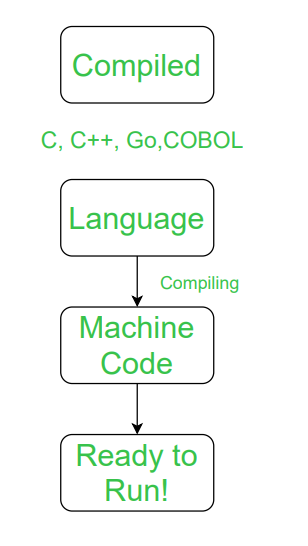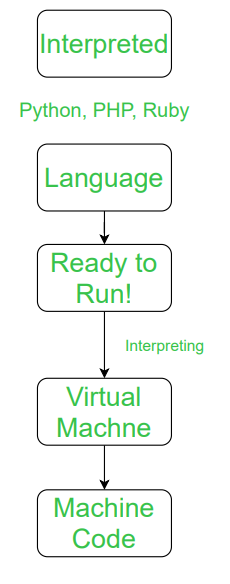先决条件 – 编译器与解释器
编译语言:
编译语言是一种通常被编译而不是解释的编程语言。它是一种程序,一旦被编译,就在目标机器的指令中表达;这个机器码是人类无法破译的。编译语言的类型——C、C++、C#、CLEO、COBOL 等。

口译语言:
解释型语言是一种编程语言,通常是解释型的,而不是将程序编译成机器指令。在这种情况下,指令不是由目标机器直接执行,而是由其他程序读取和执行。解释语言范围——JavaScript、Perl、 Python、BASIC 等。

让我们看看编译语言和解释语言之间的区别:
| S.NO. | COMPILED LANGUAGE | INTERPRETED LANGUAGE |
|---|---|---|
| 1 | A compiled language is a programming language whose implementations are typically compilers and not interpreters. | An interpreted language is a programming language whose implementations execute instructions directly and freely, without previously compiling a program into machine-language instructions. |
| 2 | In this language, once the program is compiled it is expressed in the instructions of the target machine. | While in this language, the instructions are not directly executed by the target machine. |
| 3 | There are at least two steps to get from source code to execution. | There is only one steps to get from source code to execution. |
| 4 | In this language, compiled programs run faster than interpreted programs. | While in this language, interpreted programs can be modified while the program is running. |
| 5 | In this language, compilation errors prevent the code from compiling. | In this languages, all the debugging occurs at run-time. |
| 6 | The code of compiled language can be executed directly by the computer’s CPU. | A program written in an interpreted language is not compiled, it is interpreted. |
| 7 | This language delivers better performance. | This languages delivers relatively slower performance. |
| 8 | Example of compiled language – C, C++, C#, CLEO, COBOL, etc. | Example of Interpreted language – JavaScript, Perl, Python, BASIC, etc. |